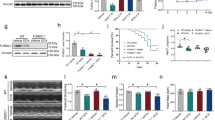Abstract
Despite its complexity of action, doxorubicin (Dox)-induced cardiomyopathy eventually results in loss of cardiac myocytes which further contributes to the development of overt heart failure. In the present study, we examined the relevance of the apoptosis repressor with caspase recruitment domain (ARC) on cardiac myocyte survival and its underlying mechanisms in a model of Dox-induced cardiotoxicity. Exposure of neonatal rat ventricular cardiomyocytes with Dox resulted in a downregulation of ARC mRNA and protein levels that occurred in a pre-translational and post-translational manner and led to a significant induction of apoptosis. Proteasomal inhibitors partially rescued both Dox-induced downregulation of ARC protein and induction of apoptosis. Knockdown of endogenous ARC sensitised cardiomyocytes to undergo apoptosis upon treatment with Dox. In contrast, enforced expression of ARC by adenoviral-mediated gene transfer dramatically increased the resistance of cardiomyocytes to undergo apoptotic cell death following Dox administration. In response to Dox, Bax translocated from cytosol to mitochondria where it resulted in dissipation of the mitochondrial membrane potential, cytochrome c release and activation of caspases -3 and -9. ARC prevented Bax translocation to the mitochondrium and thereby blocked the activation of the mitochondrial apoptotic death pathway in a t-Bid and caspase-8-independent manner. In this study, we provide evidence for the protective role of anti-apoptotic ARC in Dox-induced cardiotoxicity, which makes this molecule an interesting target for future therapies.







Similar content being viewed by others
References
Singal PK, Iliskovic N (1998) Doxorubicn-induced cardiomyopathy. N Engl J Med 339:900–905
Fujimura L, Matsudo Y, Kang M, Takamori Y, Tokuhisa T, Hatano M (2006) The protective roles of nitric oxide and superoxide dismutase in adriamycin-induced cardiotoxicity. Cardiovasc Res 69:186–197
Kunisada K, Tone E, Negoro S, Nakaoka Y, Oshima Y, Osugi T et al (2002) Bcl-xl reduces doxorubicin-induced myocardial damage but fails to control cardiac gene downregulation. Cardiovasc Res 53:936–943
Kostin S, Pool L, Elsasser A, Hein S, Drexler HC, Arnon E, Hayakawa Y, Zimmermann R, Bauer E, Klovekorn WP, Schaper J (2003) Myocytes die by multiple mechanisms in failing human hearts. Circ Res 92:715–724
Wencker D, Chandra M, Nguyen K, Miao W, Garantziotis S, Factor SM, Shirani J, Armstrong RC, Kitsis RN (2003) A mechanistic role for cardiac myocyte apoptosis in heart failure. J Clin Invest 111:1497–1504
Donath S, Li P, Willenbockel C, Al-Saadi N, Gross V, Willnow T et al (2006) Apoptosis repressor with caspase recruitment domain is required for cardioprotection in response to biomechanical and ischemic stress. Circulation 113:1203–1212
Nam YJ, Mani K, Ashton AW, Peng CF, Krishnamurthy B, Hayakawa Y, Lee P, Korsmeyer SJ, Kitsis RN (2004) Inhibition of both the extrinsic and intrinsic death pathways through nonhomotypic death-fold interactions. Mol Cell 15:901–912
Neuss M, Monticone R, Lundberg MS, Chesley AT, Fleck E, Crow MT (2001) The apoptotic regulatory protein ARC prevents oxidant stress-mediated cell death by preserving mitochondrial function. J Biol Chem 276:33915–33922
Koseki T, Inohara N, Chen S, Nunez G (1998) ARC, an inhibitor of apoptosis expressed in skeletal muscle and heart that interacts selectively with caspases. Proc Natl Acad Sci USA 95:5156–5160
Li PF, Li J, Muller EC, Otto A, Dietz R, von Harsdorf R (2002) Phosphorylation by protein kinase CK2: a signaling switch for the caspase-inhibiting protein ARC. Mol Cell 10:247–258
Foo RS, Chan LKW, Kitsis RN, Bennett MR (2006) Ubiquitination and degradation of the anti-apoptotic protein ARC by MDM2. JBC 282:5529–5535
Nomura M, Shimizu S, Sugiyama T, Narita M, Ito T, Matsuda H, Tsujimoto Y (2003) 14-3-3 Interacts directly with and negatively regulates pro-apoptotic Bax. J Biol Chem 278:2058–2065
Guo B, Zhai D, Cabezas E, Welsh K, Nouraini S, Satterthwait AC, Reed JC (2003) Humanin peptide suppresses apoptosis by interfering with Bax activation. Nature 423:456–461
Sawada M, Hayes P, Matsuyama S (2003) Cytoprotective membrane-permeable peptides designed from the Bax-binding domain of Ku70. Nat Cell Biol 5:352–357
Wang L, Ma W, Markowich R, Lee WL, Wang PH (1998) Insulin-like growth factor I modulates induction of apoptotic signaling in H9c2 cardiac muscle cells. Endocrinolgy 139:1354–1360
Nam YJ, Mani K, Lily W, Peng CF, Calvert JW, Foo RSY et al (2006) The apoptosis inhibitor ARC undergoes ubiquitin-proteasomal-mediated degradation in response to death stimuli. JBC 282:5522–5528
Li YZ, Lu DY, Tan WQ, Wang JX, Li PF (2008) p53 initiates apoptosis by transcriptionally targeting the antiapoptotic protein ARC. Mol Cell Biol 28:564–574
Green PS, Leeuwenburgh C (2002) Mitochondrial dysfunction is an early indicator of doxorubicin-induced apoptosis. Biochim Biophys Acta 1588:94–101
Korsmeyer SJ, Wei MC, Saito M, Weiler S, Oh KJ et al (2000) Proapoptotic cascade activates BID, which oligomerizes BAK or BAX into pores that result in the release of cytochrome c. Cell Death Differ 7:1166–1173
Degli Esposti M, Dive C (2003) Mitochondrial membrane permeabilisation by Bax/Bak. Biochem Biophys Res Commun 304:455–461
Oltvai ZN, Milliman CL, Korsmeyer SJ (1993) Bcl-2 heterodimerizes in vivo with a conserved homolog, Bax, that accelerates programmed cell death. Cell 74:609–619
Shan YX, Liu TJ, Su HF, Samsamshariat A, Mestril R, Wang PH (2003) Hsp10 and Hsp 60 modulate Bcl-2 family and mitochondria apoptosis signalling induced by doxorubicin in cardiac muscle cells. J Mol Cell Cardiol 35:1135–1143
Ueno M, Kakinuma Y, Yuhki K, Murakoshi N, Iemitsu M, Miyauchi T, Yamaguchi I (2006) Doxorubicin induces apoptosis by activation of caspase-3 in cultured cardiomyocytes in vitro and rat cardiac ventricles in vivo. J Pharmacol Sci 101:151–158
Acknowledgements
We thank Marlies Grieben and Janet Lips for her excellent technical assistance. This work was supported by a grant from the Bundesministerium für Bildung und Forschung (German Heart Failure Network).
Author information
Authors and Affiliations
Corresponding author
Additional information
Junfeng An and Peifeng Li have contributed equally.
Electronic supplementary material
Below is the link to the electronic supplementary material.
Supplementary material
(PPT 35928 kb)
Rights and permissions
About this article
Cite this article
An, J., Li, P., Li, J. et al. ARC is a critical cardiomyocyte survival switch in doxorubicin cardiotoxicity. J Mol Med 87, 401–410 (2009). https://doi.org/10.1007/s00109-008-0434-z
Received:
Revised:
Accepted:
Published:
Issue Date:
DOI: https://doi.org/10.1007/s00109-008-0434-z




